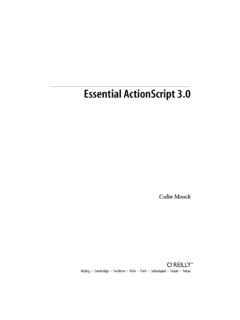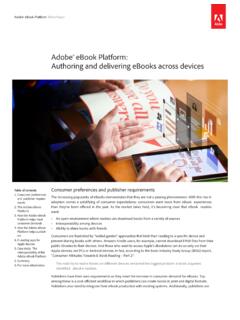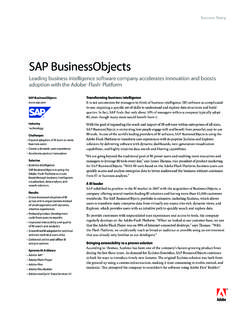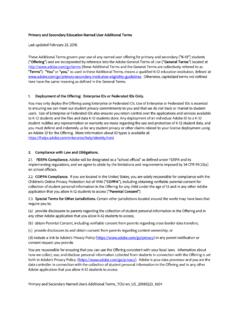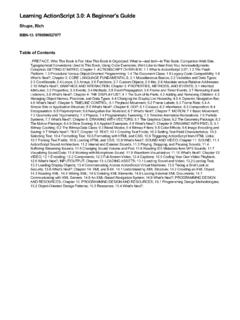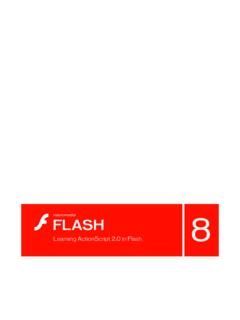Transcription of Adobe Presents
1 Adobe PresentsColin Moock s actionscript From the Ground Up TourMaterials provided by O Reilly Media, From the Ground Up23 actionscript From the Ground UpWelcomeWelcome to the actionscript : From the Ground Up Tour! In collaboration with Colin Moock, FITC Design and Technology Events, O Reilly, and participating academic institutions around the world, Adobe is thrilled to bring you this world-class day of training. Following the tradition of Flex Camp ( ) and the onAIR bus tour ( ), this lecture is an important part of Adobe s ongoing initiative to bring knowledge to the development community. At Adobe , we understand that a tool is only useful when you know how to use it. And we re committed to helping you gain that knowledge.
2 So sit back, get ready for a high-paced day of learning , and most of all have fun!Links and ResourcesThe entire set of notes for today s lecture are available at: code for the virtual zoo application can be obtained at: a prose version of today s lecture in book form, see Colin Moock s Essential actionscript (O Reilly, 2007). Details about the book are included on the back cover of this program. For more books on Adobe technologies, see the Adobe Developer Library series, at :00-10:30 First Steps: Programming tools, classes and objects, packages10:30-10:45 Break10:45-12:30 Variables, values, references, methods12:30-1:30 Lunch Break1:15-2:45 Conditionals, loops, Boolean logic, encapsulation, static members2:45-3:00In-Room Break3:00-4:30 Functions, inheritance, compilation, type annotations, datatypes4:30-4:45 Break4:45-6.
3 00 Events, display, image loading, text, interactivityKey LearningThe following table lists some of today s most important are blueprints for VirtualPet {}Objects (or instances) are the things in a program, such as a number, a car, a button, a point in timenew VirtualPet()Some classes are built into actionscript , others are , TextField, Sound, StringA package contains a class so its name doesn t conflict with other zoo { class VirtualPet { }}A constructor method initializes VirtualPet { public function VirtualPet () { // Initialization code }}A function is a reusable set of doSomething () { // Instructions go here}A function can generate a result known as a return square (x) { return x * x;}A variable is an identifier (name) associated with a value (an object).
4 Var pet = new VirtualPet();Variables do not store values; they merely refer to firstReferenceToPet = new VirtualPet();var secondReferenceToPet = firstReferenceToPet;Local variables are temporary, used to track data within a method or function square (x) { var total = x * x; return total;} actionscript From the Ground Up45 actionscript From the Ground UpConceptExampleInstance variables describe an object s characteristicsclass VirtualPet { private var petName; private var currentCalories;}Instance methods define an object s behaviors (things it can do)class VirtualPet { public function eat (numberOfCalories) { }}Static variables track information relating to entire classclass VirtualPet { private static var maxNameLength = 20;}Static methods define behaviors relating to entire (4, 5)An argument is a value passed to a method or functioneat(100);A parameter is a local variable defined in a method or function header, whose value is set via an argument public function eat (numberOfCalories) { }The private modifier means access within this class only; protected means this class or subclasses; internal means this package; public means anywhereinternal class VirtualPet { private var petName.}
5 Public function eat (numberOfCalories) { }}A conditional is a statement that executes once when a condition is metif (testExpression) { codeBlock1 } else { codeBlock2 }A loop is a statement that executes for as long as a condition is metwhile (testExpression) { codeBlock }ConceptExampleIn an instance method, this means the object through which the method was invokedpublic function eat (numberOfCalories) { += numberOfCalories;}In an constructor method, this means the object being initializedpublic function VirtualPet () { = Stan ;}Inheritance is a relationship between two or more classes where one borrows (or inherits) the variable and method definitions of anotherpublic class Food {} public class Apple extends Food { }A datatype is a set of values.
6 Every class defines a datatype: the set of instances of that class, plus instances of descendant classes. Type annotations tell the compiler the datatype of a variable, parameter, or function return VirtualPet { private var petName:String;}The compiler uses type annotations to detect reference errors at compile : Call to a possibly undefined method eatt through a reference with static type cast operation tells the compiler the datatype of a single value, and can result in a runtime type (foodItem).hasWorm()Every .swf file must have a main class. A .swf file s main class must inherit from either Sprite or class VirtualZoo extends Sprite {}At runtime, Flash creates an instance of the .swf file main class automatically, then adds it to the screen ( , puts it on the display list).
7 The display list is the hierarchy of all objects currently eligible for screen display in Flash Player. actionscript From the Ground Up67 actionscript From the Ground UpConceptExampleKey classes for displaying things include: DisplayObject: base display class InteractiveObject: adds mouse/keyboard functionality DisplayObjectContainer: adds containment for grouping Sprite: adds dragability, button-style interaction features MovieClip: adds timeline control To put an object on screen, use addChild() and removeChild(). (hungryIcon);To load an external display asset, use the Loader = new Loader(); (new URLR equest( ));Event dispatching is a system for one object to tell other objects that something happened event: the thing that happened event target: the object to which the event pertains event listeners: methods that register to be notified of the event To register for an event, use addEventListener().
8 ( , appleBtnClick);Remember, learning to program is a life-long OverviewActionScript is an object-oriented language for creating applications and scripted multimedia content for playback in Flash client runtimes (such as Flash Player and Adobe AIR). With a syntax reminiscent of Java and C#, actionscript s core language should be familiar to experienced programmers. For example, the following code creates a variable named width, of type int (meaning integer), and assigns it the value 25:var width:int = 25;The following code creates a for loop that counts up to 10:for (var i:int = 1; i <= 10; i++) { // Code here runs 10 times}And the following code creates a class named Product:// The class definitionpublic class Product { // An instance variable of type Number var price:Number.}
9 // The Product class constructor method public function Product () { // Code here initializes Product instances } // An instance method public function doSomething ():void { // Code here executes when doSomething() is invoked }}The Core LanguageActionScript s core language is based on the ECMAS cript 4th edition language specification, which is still under development as of October 2007. The ECMAS cript 4 specification can be viewed at http://developer. The actionscript specification can be viewed at the future, actionscript is expected to be a fully conforming implementation of ECMAS cript 4. Like actionscript , the popular web browser language JavaScript is also based on ECMAS cript. The future Firefox web browser is expected to implement JavaScript using the same code base as actionscript , which was contributed to the Mozilla Foundation by Adobe in November, 2006 (for information, see ).
10 actionscript From the Ground Up89 actionscript From the Ground UpECMAS cript 4 dictates actionscript s basic syntax and grammar the code used to create things such as expressions, statements, variables, functions, classes, and objects. ECMAS cript 4 also defines a small set of built-in datatypes for working with common values (such as String, Number, and Boolean). Some of actionscript s key core-language features include: First-class support for common object-oriented constructs, such as classes, objects, and interfaces Single-threaded execution model Runtime type-checking Optional compile-time type-checking Dynamic features such as runtime creation of new constructor functions and variables Runtime exceptions Direct support for XML as a built-in datatype Packages for organizing code libraries Namespaces for qualifying identifiers Regular expressionsAll Flash client runtimes that support actionscript share the features of the core language in common.
